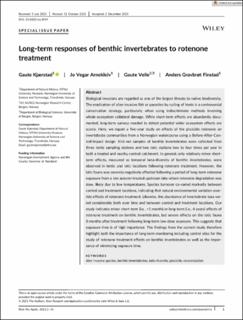| dc.description.abstract | Biological invasions are regarded as one of the largest threats to native biodiversity. The eradication of alien invasive fish or parasites by culling of hosts is a controversial conservation strategy, particularly when using indiscriminate methods involving whole ecosystem collateral damage. While short-term effects are abundantly documented, long-term surveys needed to detect potential wider ecosystem effects are scarce. Here, we report a five-year study on effects of the piscicide rotenone on invertebrate communities from a Norwegian watercourse using a Before-After-Control-Impact design. Kick-net samples of benthic invertebrates were collected from three lentic sampling stations and two lotic stations two to four times per year in both a treated and nearby control catchment. In general, only relatively minor short-term effects, measured as temporal beta-diversity of benthic invertebrates, were observed in lentic and lotic locations following rotenone treatment. However, the lotic fauna was severely negatively affected following a period of long-term rotenone exposure from a late autumn treated upstream lake where rotenone degradation was slow, likely due to low temperatures. Species turnover co-varied markedly between control and treatment locations, indicating that natural environmental variation override effects of rotenone treatment. Likewise, the abundance of invertebrate taxa varied considerably both over time and between control and treatment locations. Our study indicates minor short-term (i.e., <1 month) or long-term (i.e., 4 years) effects of rotenone treatment on benthic invertebrates, but severe effects on the lotic fauna 8 months after treatment following long-term low-dose exposure. This suggests that exposure time is of high importance. The findings from the current study therefore highlight both the importance of long-term monitoring including control sites for the study of rotenone treatment effects on benthic invertebrates as well as the importance of minimizing exposure time. | en_US |

